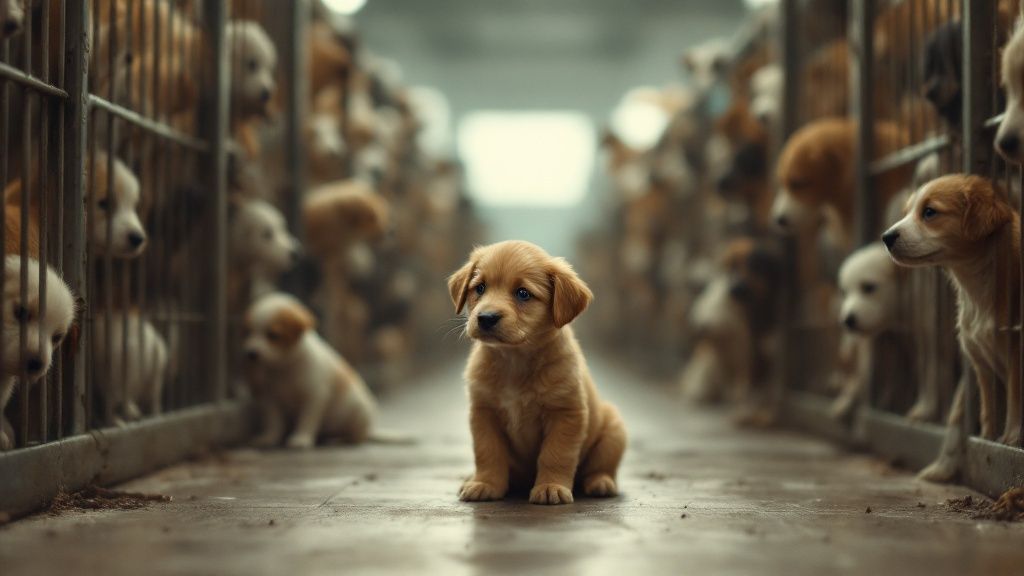How to Spot a Puppy Mill: Expert Tips
- f85661678
- Apr 1
- 13 min read
The Dark Reality Behind Puppy Mills

Beyond the charming pet store displays and enticing online ads, a harsh reality lurks: the puppy mill. These commercial breeding operations prioritize profit over animal welfare, creating a breeding ground for neglect and suffering. This disregard for the dogs' well-being perpetuates a cycle of abuse impacting countless animals. Understanding this dark side of the pet industry is crucial for making informed decisions and combating this cruel practice.
What Exactly Is a Puppy Mill?
Puppy mills focus on mass production, treating dogs as commodities instead of living creatures. These facilities often house large numbers of breeding dogs in cramped, unsanitary conditions. Basic necessities like proper veterinary care, nutritious food, and socialization are routinely neglected, severely compromising the dogs' physical and psychological health. For example, mother dogs may be bred continuously with minimal recovery time, leading to exhaustion and weakened immune systems.
The puppies born in these environments often suffer from health and behavioral problems. They are susceptible to diseases, genetic defects, and emotional trauma due to the lack of early socialization. These issues often remain hidden until after purchase, leaving families heartbroken and facing unexpected veterinary expenses. This devastating cycle continues largely due to a lack of public awareness about how to identify these operations. Understanding their scale and prevalence is a key first step.
The United States is estimated to have approximately 10,000 puppy mills, with less than 3,000 regulated by the U.S. Department of Agriculture (USDA). These facilities are notorious for inhumane conditions, such as overcrowding and poor sanitation, which contribute to health issues in puppies. Alarmingly, roughly 70% of puppy mills operate illegally, making regulatory oversight extremely challenging. The sheer number of facilities highlights the widespread nature of this issue, with many operating undetected by authorities. For a more in-depth look at the statistics, visit https://total.vet/puppy-mill-statistics/.
Why Do Puppy Mills Persist?
Despite the horrific conditions and widespread condemnation, puppy mills persist due to a combination of factors. High demand for puppies, coupled with a lack of public awareness about the realities of puppy mills, is a significant contributor. Many well-intentioned buyers purchase puppies from pet stores or online, unaware of their origin. This demand creates a profitable market for puppy mill operators.
Another factor is the difficulty in regulation and enforcement. The illegal nature of many puppy mills allows them to operate under the radar, continuing their practices unchecked. Being an informed consumer and understanding how to identify a puppy mill is crucial for combating this problem and protecting animal welfare.
Facility Red Flags That Cannot Be Overlooked
When visiting a potential breeder, your own observations can be invaluable. A responsible breeder will be happy to show you their facility, while a puppy mill operator will likely be evasive. This section highlights the physical warning signs that distinguish a legitimate breeder from a puppy mill.
Concerning Living Conditions
One immediate red flag is the cleanliness of the facility. Look for overcrowding, such as stacked cages or animals crammed into small spaces. The smell is also telling; a strong ammonia odor indicates inadequate cleaning. Proper ventilation and temperature control are essential. Excessive heat or cold, coupled with poor airflow, can create unhealthy conditions. For example, dogs in wire cages without bedding in a drafty barn experience extreme discomfort.

Troubling Facility Layouts
Knowing where puppies come from is crucial. For more on adopting ethically, read about ethical sourcing. Responsible breeders will show you where the dogs live, indoors and outdoors. If a breeder avoids a full tour, or declares areas "off-limits," be wary. Puppy mills often hide their worst conditions. Also, look for adequate exercise areas. Dogs need room to run and play. The absence of enrichment activities, like toys, suggests a disregard for their psychological well-being.
Inadequate Care and Socialization
Observe the dogs’ condition. Unkempt coats, wounds, or signs of illness indicate neglect. How do the dogs interact with the breeder and each other? Puppy mill dogs, lacking socialization, often exhibit fear, anxiety, or aggression. They may cower, bark excessively, or show little interest in interacting. Excessive barking or whining signals stress and boredom.
To help illustrate the key differences, let's look at the following comparison:
Legitimate Breeder vs. Puppy Mill Comparison: This table contrasts the notable differences between responsible breeders and puppy mills to help potential pet owners recognize warning signs.
Characteristic | Responsible Breeder | Puppy Mill |
|---|---|---|
Cleanliness | Clean, well-maintained spaces | Dirty, overcrowded conditions, strong ammonia smell |
Animal Appearance | Healthy, well-groomed dogs | Unkempt coats, potential wounds or signs of illness |
Transparency | Open to showing entire facility | Reluctant to give full tours, areas may be "off-limits" |
Exercise Areas | Provides adequate space for exercise and play | Confined spaces, lack of exercise areas |
Socialization | Dogs are well-socialized, interact positively | Dogs show signs of fear, anxiety, or aggression due to lack of socialization |
Animal Welfare | Prioritizes the health and well-being of the dogs | Focuses on profit over animal welfare |
This table clearly highlights the stark contrast between responsible breeders and puppy mills. The differences extend beyond physical conditions to the core values guiding their operations.
One of the most telling signs of a puppy mill is prioritizing profit over welfare. Puppy mills sell an estimated 2.6 million puppies annually, with each female producing about 9.4 puppies per year. A breeding dog's life is often cut short when they can no longer reproduce. Puppies from mills are prone to health issues, being 41.6% more likely to develop problems than the general dog population. Learn more about puppy mills.
By recognizing these red flags, you can avoid supporting inhumane practices and bring home a healthy, well-adjusted puppy.
Breeder Behavior That Signals Trouble
The way a breeder interacts with you can reveal a lot about their operation. It provides insights into their priorities: are they focused on animal welfare or simply maximizing profits? Understanding the subtle, and sometimes not-so-subtle, behavioral red flags of a puppy mill can help you make informed decisions and potentially save a dog from a difficult life.

High-Pressure Sales Tactics
Responsible breeders prioritize finding the right home for their puppies. They'll likely ask you many questions to ensure a good fit. Puppy mill operators, on the other hand, are driven by quick sales. They often employ high-pressure sales tactics, urging you to make an immediate decision, claiming the puppy won't be available for long. This pressure discourages thoughtful consideration and thorough questioning.
Evasive Answers and Lack of Transparency
Transparency is a hallmark of responsible breeders. They welcome questions about their dogs' health, living conditions, and breeding practices. Puppy mill operators, however, tend to be evasive, providing vague or inconsistent answers about lineage or medical history. This lack of transparency is a significant warning sign. Reputable sellers are proud of their practices and open to sharing information.
Limited Access to the Facility and Dogs
A key red flag is restricted access. Reputable breeders are happy to show you where their dogs live and let you interact with the puppies' parents. Puppy mill operators often restrict access, citing the dogs’ “protection.” This is frequently a cover for substandard conditions. Restricting access prevents potential owners from making informed choices.
Disregard for the Puppy's Well-Being
Responsible breeders genuinely care about their puppies’ futures. They inquire about your lifestyle, experience with dogs, and capacity to provide a loving home. A puppy mill operator demonstrates little concern for the puppy's well-being beyond the sale. They’re unlikely to ask about your home or provide guidance on puppy care. This indifference is a strong sign of profit-driven motivation.
By recognizing these behavioral red flags, you can differentiate between responsible breeders and puppy mill operators. This empowers you to make informed decisions, support animal welfare, and bring home a healthy puppy from a reputable source. If a breeder exhibits any of these behaviors, walk away and continue your search. Report any suspicious activity to the U.S. Animal Abuse Registry to help combat this inhumane practice.
Reading a Puppy's Health and Behavior Signals
Puppies, much like children, often can't hide the truth about their past. Understanding a puppy's health and behavior can offer valuable insights into their early life and help you identify a puppy mill. This knowledge empowers you to make informed decisions and potentially rescue a dog from a difficult life.

Identifying Concerning Physical Signs
A puppy's physical condition offers important clues. A dull, matted coat, for instance, can suggest neglect and possible underlying health problems. Likewise, discharge from the eyes or nose, persistent coughing, or labored breathing could point to respiratory infections, common in the overcrowded conditions of puppy mills.
Examine the puppy's ears. Redness, swelling, or a foul odor are signs of possible ear infections, often stemming from poor hygiene. Also, check for skin irritations, parasites like fleas or ticks, and any wounds. These can all indicate inadequate care and unsanitary living conditions.
Recognizing Behavioral Red Flags
A puppy's behavior is just as important as its physical health. Puppies from puppy mills often display unusual fear responses. Due to a lack of proper socialization, they might cower, tremble, or shy away from human interaction. This early deprivation can result in long-term socialization challenges and anxiety.
Extreme timidity or aggression are additional warning signs. These behaviors often arise from the fear and stress experienced in a mill environment. Observe how the puppy interacts with other dogs and people.
A healthy puppy will usually exhibit curiosity and a playful attitude. In contrast, a puppy mill puppy might show little interest or even fear when interacting socially.
Understanding Healthy Puppy Development
To spot deviations, it's essential to understand normal puppy development. Puppies reach specific milestones at different ages. A healthy puppy will typically begin exploring and interacting with its littermates within a few weeks.
By eight weeks, most puppies are playful and curious, displaying healthy social behavior. Recognizing these milestones helps you identify developmental delays, which may indicate a lack of proper care and stimulation in a puppy mill. Knowing this contrast between healthy and unhealthy development is vital to identifying a puppy mill.
Long-Term Consequences of Early Warning Signs
Overlooking early health and behavioral warning signs can have serious long-term consequences. Untreated medical problems can become chronic illnesses, leading to extensive and expensive veterinary care. Behavioral issues can also persist into adulthood, affecting the dog's quality of life and its bond with its owner.
To further illustrate these potential problems, let's look at a table outlining some common health issues found in puppy mill dogs.
Health Warning Signs in Puppies: This table outlines common health issues found in puppy mill dogs compared to properly bred puppies, including typical symptoms and potential long-term consequences.
Health Concern | Signs in Puppy Mill Dogs | Long-term Impact |
|---|---|---|
Respiratory Infections | Coughing, sneezing, nasal discharge | Chronic respiratory problems, pneumonia |
Ear Infections | Redness, swelling, discharge, odor | Hearing loss, chronic pain |
Skin Issues | Parasites, irritation, wounds | Secondary infections, chronic skin conditions |
Genetic Disorders | Hip dysplasia, eye problems, heart defects | Pain, reduced mobility, shortened lifespan |
Behavioral Problems | Fear, anxiety, aggression | Difficulty bonding, social challenges |
As this table shows, the impact of neglecting early signs can be significant, affecting a dog's long-term health and well-being. By being aware of these potential issues, you can make a more informed decision when choosing a puppy and help prevent future suffering. These observations, along with other factors like the breeder's practices and the condition of their facility, give you the tools to avoid supporting inhumane breeding and bring home a happy, healthy puppy.
Documentation Discrepancies That Matter
Legitimate paperwork tells a story that puppy mills can't fabricate. This section guides you through evaluating breeder documentation with a discerning eye. You'll learn to differentiate between the thorough records of responsible breeders and the often incomplete or misleading paperwork from puppy mills. Decoding these differences is crucial in the fight against inhumane breeding.
Decoding Health Certifications and Registrations
Responsible breeders keep detailed health records. They readily share certifications from reputable veterinarians, proving their dogs are free from genetic diseases and have received necessary vaccinations. These records often detail regular check-ups, preventative care, and any addressed health issues. Puppy mills, however, may provide generic or even forged documents. Look for specifics, including dates, veterinarian contact information, and individual dog identification. Vague or incomplete information is a significant red flag.
Responsible breeders often register their dogs with established kennel clubs like the American Kennel Club (AKC). While registration doesn't guarantee ethical breeding, it indicates a commitment to breed standards, a step often skipped by profit-focused puppy mills. Verify any registration numbers with the kennel club to confirm their validity. This check can uncover inconsistencies a puppy mill hopes you’ll miss.
Spotting Inconsistent Medical Records and Breeding Timelines
Scrutinize medical records beyond basic health certifications. Responsible breeders maintain comprehensive histories for each dog, including vaccinations, treatments, and any illnesses or injuries. These offer valuable insight into a dog’s overall health. Puppy mills may provide incomplete or inconsistent histories. Gaps in vaccinations, missing records for common puppyhood illnesses, or vague treatment descriptions should raise concerns.
Examine breeding timelines. Responsible breeders allow sufficient time between litters for the mother's physical and emotional recovery. Puppy mills, driven by profit, often breed continuously, stressing the mother's health. Suspicious breeding frequency combined with incomplete medical records strongly suggests a puppy mill.
Understanding Legitimate Health Guarantees
Responsible breeders often offer reasonable health guarantees, covering specific genetic conditions for a set period. These demonstrate a commitment to puppy well-being and provide buyer protection. Puppy mills might also offer guarantees, but these are often vaguely worded or difficult to enforce. Review any guarantee, noting the conditions covered, duration, and claim process. A guarantee that seems too good to be true or lacks specifics is likely a deceptive tactic.
By carefully examining breeder documentation, you can uncover vital information revealing the truth about their practices. This informed approach helps avoid supporting inhumane puppy mills and ensures you bring home a healthy puppy from a responsible source. Remember, responsible breeders are transparent and welcome your questions. They understand informed buyers are key to ending the cruel practices of puppy mills.
Digital Detective Work That Reveals The Truth
Your smartphone can be a powerful tool for uncovering the truth about a potential breeder. Online research can reveal hidden information, separating responsible breeders from puppy mills. This digital detective work empowers you to make informed decisions, potentially saving a dog from a life of misery.
Unveiling Hidden Truths Through Online Research
Start with a thorough online search of the breeder's name and location. Look for consistency across different platforms. Discrepancies, such as varying kennel names or locations, warrant further investigation. Also, check for an established online presence. A legitimate breeder will likely have a website and social media accounts showcasing their dogs and breeding practices.
A lack of online presence, or one that seems hastily constructed, could be a red flag. It might indicate a puppy mill trying to avoid scrutiny. Take your time and be thorough in this initial phase of research.
Leveraging the Power of Reviews and Testimonials
Online reviews offer valuable insights into a breeder's reputation. Search for breeder reviews on platforms like Google, Yelp, and the Better Business Bureau. Look for recurring complaints about puppy health, breeder communication, or questionable sales practices.
While a few negative reviews are normal, numerous complaints about similar issues should raise red flags. Be wary of overwhelmingly positive reviews that sound generic or lack specific details. These could be fabricated. This step is critical in identifying a potential puppy mill.
Analyzing Websites for Red Flags
A breeder's website can reveal a great deal about their operation. Look for clear and detailed information about their breeding practices, health testing protocols, and puppy-raising philosophy. Vague descriptions, the use of stock photos, or an overemphasis on puppy availability without mentioning parent dogs or health information are potential warning signs.
Be cautious of websites offering multiple breeds, especially if those breeds have vastly different care requirements. This could indicate a high-volume operation that prioritizes profit over individualized care for the animals.
Reverse Image Search: Exposing Stolen Puppy Photos
Puppy mills frequently use stolen photos to lure potential buyers. Conduct a reverse image search using images from the breeder's website or online advertisements. This simple technique can reveal if the photos are used elsewhere, potentially exposing scams and deceptive practices.
If a photo appears on multiple websites associated with different breeder information, it's a strong indication of fraudulent activity. This is a quick and effective way to identify potentially misleading information.
Accessing USDA Inspection Databases
For breeders claiming USDA licensing, verify their claims through the USDA’s online inspection database. This resource provides inspection reports detailing any violations discovered during USDA visits. While not all breeders are required to be USDA licensed, those who are should have readily available and transparent records.
Repeated violations or serious infractions are significant red flags and should give you pause. This information can be crucial in assessing a breeder's legitimacy.
Tapping into Breed Club Resources
Breed clubs are invaluable resources for finding reputable breeders. These organizations maintain lists of breeders adhering to breed standards and ethical practices. Consulting breed club resources can help you identify responsible breeders committed to animal welfare.
They also frequently offer breed-specific health information, essential for understanding potential health issues and making informed decisions. Reach out to your local breed club for recommendations.
Utilizing Rescue Organizations as Information Hubs
Local rescue organizations often possess valuable information about breeders in their area. They can provide insights into a breeder’s reputation and alert you to potential puppy mills operating in your region. This local knowledge complements your online research, painting a more comprehensive picture.
By combining these digital detective techniques with real-world observations and direct questions to the breeder, you can effectively identify and avoid puppy mills. Reporting suspicious breeders to organizations like the U.S. Animal Abuse Registry helps combat this inhumane practice.
Taking Action Against Suspected Puppy Mills
Identifying a puppy mill is a crucial first step, but taking action is where real change happens. This section provides the tools you need to effectively report suspected puppy mills and help end this cruel practice. Knowing the signs is only half the battle; reporting is how we make a difference.
Documenting Evidence Effectively
Before filing a report, gather compelling evidence. Strong documentation helps authorities take the appropriate action.
Photographs and Videos: If possible, document the facility's conditions, the dogs' health, and any worrisome behaviors.
Written Records: Keep copies of all communication with the breeder, including emails, text messages, and advertisements. Note dates, times, and specific details.
Witness Accounts: If others have observed the same conditions, gather their statements.
This documentation provides concrete proof to support your claims and builds a stronger case.
Reporting to the Appropriate Authorities
Reporting suspected puppy mills involves understanding various channels to ensure your report reaches the right people.
Local Animal Control: Your local animal control is the first line of defense. They investigate suspected violations within their jurisdiction.
State Agencies: Contact your state's animal welfare department or attorney general's office for cases that cross jurisdictional lines or involve larger operations.
National Organizations: Organizations like the Humane Society of the United States (HSUS) https://www.humanesociety.org/ and the ASPCA https://www.aspca.org/ accept reports and provide resources for combating puppy mills.
Law Enforcement: If you suspect criminal activity, such as animal cruelty or fraud, contact your local police or sheriff's department.
Reporting suspected puppy mills can prevent further animal suffering. Use these channels to ensure appropriate action.
Understanding the Reporting Process and Its Aftermath
Reporting a suspected puppy mill initiates an investigation. Authorities will assess the evidence and determine if violations occurred. The process can involve inspections, interviews, and potential legal action.
Be prepared to cooperate with investigators and provide requested documentation. Investigations can take time, and the outcome varies depending on the case specifics and local laws.
Consumer Protection Laws and Advocacy Groups
If you unknowingly purchased a puppy from a puppy mill, consumer protection laws may offer recourse. Some states have "puppy lemon laws," providing remedies for consumers who purchase sick puppies. Connect with advocacy groups working to end puppy mills for support, resources, and legal guidance.
Raising Community Awareness
Raising public awareness is vital. Educating your community about how to identify a puppy mill prevents others from unknowingly supporting these cruel operations. Share information on social media, organize educational events, and support local shelters and rescue groups.
Taking action against suspected puppy mills requires persistence and community effort. By documenting evidence, reporting correctly, and raising awareness, you can help shut down these operations and create a better future for animals.
Support the U.S. Animal Abuse Registry (https://www.usaar.org) to further contribute to ending animal abuse. Your contribution supports investigations, public awareness campaigns, and legal action.
Comments